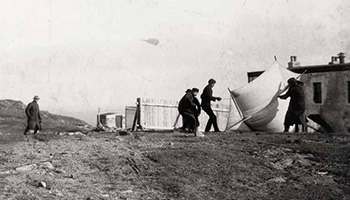Other Women Walk: A Sneak Peak
BY NQ
August 2019
Other Women Walk is a historical walking tour featuring multiple performances at standing stops in and around Bannerman Park. Three actors – Wendi Smallwood, Monica Walsh, and Marie Jones – enact stories of women living on the margins of the suffrage movement in 1922 St John’s. Director/writer Ruth Lawrence shared some of the script:
The audience heads towards 63 Military Road, stopping at the corner of Bannerman and Military.
HELEN FUREY:
There at 63 Military Rd is a three-storey row house. It’s the green one. It’s typical of downtown St John’s. Julia Salter Earle lives here. She married Arthur Earle, a jeweler who is a member of the NIWA, the Newfoundland Industrial Workers Association, the union. They have six children together but Julia also works full time. She has a government job as an engrossing clerk. So she writes out each copy of the statutes passed by the Legislative Assembly, in there. She’s our leading organizer for workers’ rights.
Julia and her cohorts sometimes find themselves on opposite sides to the women of the Ladies Reading Room. That’s the crowd downtown stirring up Prime Minister Squires and the government about getting the vote. But each side knows that their work is to raise all women up.
They see Beulah approach. Forceful and pragmatic, she has a withered left hand that she shields inside her coat.
Here comes one of Julia’s charges, Beulah Bishop. As a very young girl, she suffered a workplace accident, working at the Foundry. She’s disabled now. Not marriageable. Highly motivated.
BEULAH BISHOP:
Excuse me, excuse me, can I have a moment of your time? That’s a lovely blazer/jacket/coat you have on, madam. Yours is well crafted, too, sir. What seamstress made that for you?
You’re not sure? Well, it’s a pleasure to meet a well-turned out crowd such as this.
I appreciate a finely made coat, as you can see. Sewn sturdily, well pressed. Look at these buttons, that’s a strong knot there, with the thread crossed over. Horizontal buttonholes, that’s your sure sign of hand tailoring.
I’m a member of the Ladies Branch of the NIWA. Each for all, all for each is our motto. But really, I’m a working girl. Girl.
The newspapers said that girl workers from factories around St John’s – the Newfoundland Clothing Company, Colonial Cordage, and Browning’s Biscuit Factory, all of them and more –came to our meeting. They may have called them girl workers but 60 women joined the union that night. Julia Salter Earle was elected president, Josephine Kennedy her vice president, me, Beulah Bishop, as treasurer. Within three weeks, Julia had met with the manager of the Newfoundland Knitting Mills, with my manager, and just three weeks later, our membership had grown to over two hundred working women. Not girls. Women. After that, the Parker & Monroe crowd joined up and by fall, we were 400 strong.
But we’re just getting started. Besides working at the Mill for $2 a week, before deductions, we spend our free time, what we have, working for the union. We’re going to improve the conditions in our factories. We still have child labour in our factories. That’s a shameful thing. Children should be playing in their yards or studying in a classroom, not slaving over a hot iron for 10, 12 hours a day. Some people, that doesn’t bother them a bit. They have money, they don’t think about the needle stabbing through six thick layers of wool, horsehair, and cotton lining to perfectly place a shoulder pad, built to make them look more powerful, to command respect. They think nothing of the one holding the needle.
I walk down the street and I hear people talking, calling me a radical. There’s lots of back-biting in this town and don’t you let anyone try and convince you it’s any different.
They used to call me lame so I prefer radical.
Do you have a head for numbers?
Alright then, add up the cost of room and board, streetcar fares, toothpaste, corsets, and other necessities of a woman’s living. (You know what I mean.) Today, that comes to $8.50! A single worker would need a weekly wage of eight dollars and fifty cents to meet the cost of living.
I make two dollars a week. We make in a month, what we need to live for a week.
Let me put it another way. Here we are today and women’s work is still not deemed as valuable as men’s work? That’s not right.
You can help, you know. Yes! There’s something you can do.
Look, if our union could get Imperial Tobacco to set up a restaurant where their workers could eat at cost, for 2 or 3 cents a meal, then surely we can do our part. That’s why I went to the Royal Store and bought this coat, to raise those women up. It’s made well, by women I know well. That’s what you can do, choose where you spend your money!
I believe in what I see. I see you, and you, and you. And when I see a young child running down the road, spinning a rim or skipping a rope, I believe that child, despite the scrapes on his knee or the patch on her flowery dress, is a future doctor, nurse, lawyer, or librarian. And it might be your child. Or yours.
I’m heading down to a meeting tonight. You’re welcome to join us. Last week, we had a concert at the end of it, and tonight I know what I’ll be singing:
I hear it singing, singing, sweetly,
Softly in an undertone,
Singing as if God had taught it-
It is better farther on!
She stops:
Oh yeah, you never did say! Do you like my new coat?
Beulah moves on
HELEN FUREY:
Remember what she said about Imperial Tobacco? Well they even appointed Dr Cluny MacPherson to their factory and he brought in medical insurance for the workers. The first of its kind here. Not long after them, Colonial Cordage followed suit. Next, the managers of the Royal Stores Clothing Factory instituted an 8-hour day. Once other managers see that, they’ll have to do the same. So the rising tide does raise all boats!
We’ll go a little farther down the road now.
Helen leads them down Military Road. They reach 55 Rennie’s Mill Rd.
HELEN FUREY:
This Queen Anne style mansion was built for Newfoundland’s 12th Prime Minister, Patrick Morris. By 1920, it was turned into Spencer Lodge, the hostel for outport girls who came to study at Bishop Spencer Collegiate, the Anglican private school.
Some people might be impressed by that grand front entryway made of English oak. I’m more impressed that Spencer’s Principal, Violet Cherrington, lives here with hundreds of girls. Imagine the racket she must endure!
Here comes Josephine Colley, she’s one of 1,400 teachers in our school system. A full three-quarters of our teachers are women. Josephine worked in Burgeo before taking a position at St Mary’s, a working-class school. It couldn’t be more different than Bishop Spencer.
Josephine approaches with an open letter in her hand.
JOSEPHINE COLLEY:
I just got a letter from my friend, Sue Grandy in Garnish. She teaches over 80 children in her class. She’s already fed up doing home economics, and now they have her teaching knitting and needlework two days a week. The men don’t have to teach it, she says, so why should she? So that’s it, she’s getting away from it – she’s getting married!
Once she does, she can’t teach anymore. That’s the rule. She could have come to town with us. It’s not the same here as it was in Burgeo. In here, they ignore us completely. My school is in awful hard shape. Someone from Columbia University came to survey it and they gave us five points out of a possible fifty-five. Seems they weren’t very impressed with our toilets. Sure, at least we got one. I mean, they complained we didn’t have a lab for chemistry lessons. I’m using a blackboard propped up on a chair!
Now Spencer is a different case. Miss Cherrington prefers the British teachers for the daughters of the upper class. She’s transforming the young barbarians of the oldest colony into genteel young ladies.
Even the middle-class girls have a brand new school. Our Lady of Mercy has 13 classrooms, 7 music rooms. They have everything, even dressing rooms and washrooms. It has an orchestra. An orchestra!
My school, St Mary’s, is impoverished and overcrowded. We’ve got one room for low grades, another room for the upper. And only a few even get to the higher grades. Some of our very best, our scholars, only get to come every so often. They’re at work. They’re supporting their families. I know, I’m doing the same, I’m boarding with my widowed sister to help her get along. But it’s hard to make any headway in their book-learning like that. I feel for them.
But I’ve got a little secret. I took some savings and bought a hectograph. I have workbooks stacked up that high and I take them home to copy them so the students can have worksheets to practice their arithmetic. Now the Council of Higher Education still got the gall to charge fees for their final exams. But if they want it, and can manage it, I’ve got to help them somehow. It’s cruel because a good education is the only chance those boys have to get out of poverty. They couldn’t have a better plan to keep them down.
Yes it’s too bad about Sue, too bad she couldn’t hold on, ‘cause big changes are coming. The Superintendent of the School Board says there’s too many women teaching in the lower grades. He says we need to show more ambition and he knows best!
If that’s what he wants, well alright. I got my sights set a little higher. Miss Cherrington has power and I thought I’d drop up a few bottles of bakeapples … and put in a good word for myself. Hopefully, she’ll pass that along. The word, not the jam.
HELEN FUREY:
That must have been some jam! Not long after, she did it! Josephine worked 20 years as principal at St Mary’s. Then again, Violet designed a curriculum of feminine virtues, good manners, and proper speech. So she wasn’t exactly training the rebels. No place for me!
We’ll head back home now to our final stop.
They walk back to the starting place.
For more info and research sources, visit https://www.otherwomenwalk.com/
Other Women Walk begins and ends at the corner of Rennie’s Mill Road and Circular Road on the park side. The performance departs at 11 am & 2 pm, Monday, Wednesday & Friday, 2 pm & 7 pm Tuesday and Thursday, from August 8- September 2, 2019 (performing rain or shine!). Admission is $10 for adults / $5 for children 12 and under, collected at the beginning of the tour, cash only, no reservations. Running time is one hour.
Free parking is available along the east side of Rennie’s Mill Road and the south side of Circular Road. The performance covers approximately 1 kilometre (0.62 miles) of easy walking over grass, gravel and pavement, with no stairs. There are some gentle inclines/declines. The performance is not recommended for non-motorized wheelchairs. Please make individual judgments accordingly.
Produced by White Rooster Theatre.
This project is supported by Arts NL, City of St John’s, Canada Summer Jobs/Service Canada, Govt of NL, and MUN’s Dept of English.




